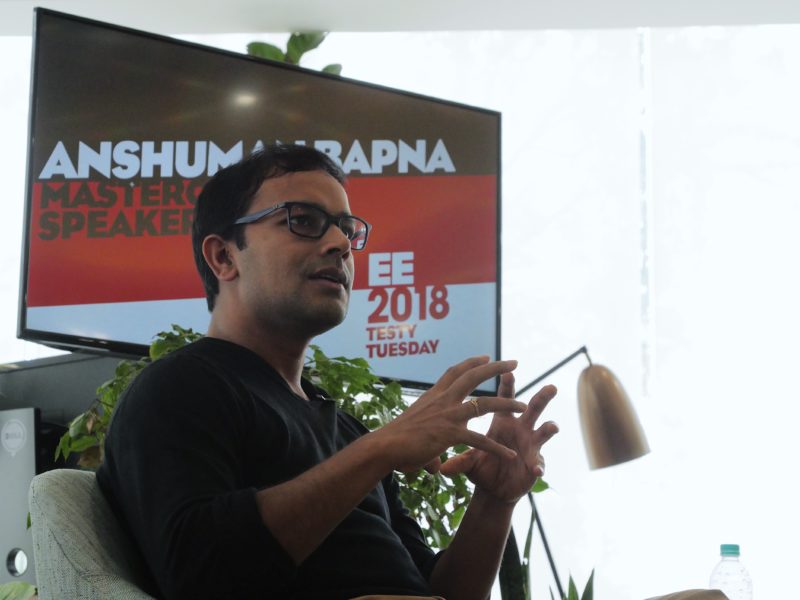On Day 4 of Lightspeed Extreme Entrepreneurs, I had the chance of engaging with Anshuman Bapna, CPO Goibibo on the enigma that is, Product Market Fit. The journey to product market fit is not simply about achieving metrics, it is a journey full of ups and downs, confusion and hundreds of unprioritized questions which entrepreneurs struggle with.
Being a serial entrepreneur, Anshuman has experienced this first hand and multiple times. He founded the incubator cell at IIT Bombay, started India’s first campus startup while at IIT- a digital content company well ahead of its time and then founded the award-winning startup Mygola in 2009.
Here are the key takeaways from the session, hope you enjoy the read!
Focus on identifying and de-risking against the biggest risks for your business
It is critical for start-ups to explicitly write the biggest risks that could lead to failure of their company and work towards de-risking those. Recalling his journey with Mygola, Anshuman shared, “Through multiple conversations with people who had tried to crack the travel market, a common theme emerged – everyone struggled with the business model, it wasn’t the product or customer acquisition or the distribution.” Thus, the ability to monetize the customers who are coming to the platform for travel planning, became the biggest risk for Mygola. In situation like these, it is very easy to have blinders on and instead focus on things which are under our control- in case of Mygola it was to build best possible product and team. Building a great product will give you a false sense of progress and you will spend months focusing your energy where you shouldn’t.
Founder-Market Fit precedes Product-Market Fit
It is important to think of founder market fit along with product market fit. While Mygola was trying to figure out the right business model, the team evaluated the option of pivoting into a pure play travel package platform from the travel planning platform. But the founders knew they didn’t have the DNA to pull off in the SME market and decided to walk away from it, which Anshuman still believes was the right decision.
Identify your North-Star metric
On how to judge the success of an MVP, Anshuman shared that it is extremely critical to define your north star upfront and to measure the results of the MVP against it. In most cases, “something” will be working. Is that the “something” that is most critical for you right now??
Often founders start believing there is product market fit when it is not – e.g: customers are flowing in organically, reviews are going up etc. But in order to de-risk against those biases it is critical to look for metrics which are most meaningful to the company- e.g: flat retention curves for certain cohorts implies that you have a potential product market fit for a set of customers. “It is possible that the market for these set of users who are loving your product is extremely small, but it is a good problem to have. You can now try to replicate the behavior in other segments”

Stay in check – Define success and set deadlines!
When asked about how to find the balance between quitting too early on an idea versus staying on for too long, Anshuman shared that it is necessary to take the time to define success for yourself. Talk to industry experts, talk to other entrepreneurs and try to define what success or product-market fit would look like for you. In this process, be as metrics driven as possible. Post that, set a deadline for yourself. For some, this deadline may be their next funding round or their cash runway. For others, it may be something personal. But use the deadline and work backwards from there to decide what you should be spending your time on and to decide when to quit, if at all!
Market always wins
When asked about what he would have done differently, Anshuman emphasised the importance of picking a great market. “Travel planning was and continues to be a tough market. If I had to do it all over again, I would choose market over product. We were pivoting but we were trying to fit in our product into a not so great market and but admitting to it became harder year after year.”
Quoting the famous saying he said, “When a great team meets a lousy market, market wins. When a lousy team meets a great market, market wins. When a great team meets a great market, something special happens.”
You only have “so many” pivots in you!
You might believe that you have a very nimble company which can quickly pivot. But the truth is that every pivot takes something away. It might take away patience from your team. It might take away “the fight” from your co-founder. It might take away some of the support from your family. “Your co-founders, employees, investors, personal life can only take so many pivots.” In Anshuman’s opinion the ideal number of pivots that everyone can take together is One!


To stay updated, follow EE on twitter here and the official Lightspeed India handle here.

